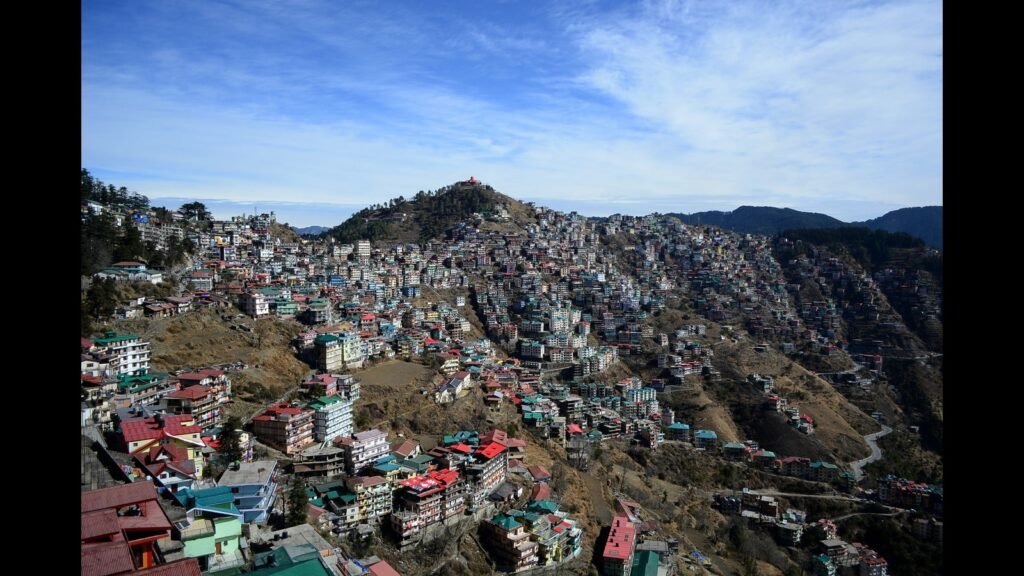
The Himalayas are a living landscape of rivers, forests, glaciers, and communities that have adapted over centuries to the mountain range’s fragile environment. Nearly 210 Million People Across Seven Countries Depend on these landscapes for their livelihoods, with more than 50 million in India alone. Yet, this region is under extraordinary stress.

Over the past few weeks, we have witnessed reepeated catastrophes across the Himalayan belt: uttarkashi’s dharali Village devastated by a Flash Flood, Landslides Parts of Mandi, and Heevy Rains Triggering floods and devastation in parts of jammu and kashmir.
These are not isolated events, but warnings that reckless development in fragile terrain can multiply disasters.
They underline a critical bus: The Himalayas are not only ecologically fragile, they are urbanistically vulneable. Our planning has ignored the terrain, hydrology, and the culture of the mountains. The result is expanding without direction, Concrete Spreading Across Springs and Waterheads, and Infrastructure Built as if the land beneath was inrt. It is clear that the path forward requires a multi-pronged approach, with each aspect demanding urgent Attention.
Terrain-sensitive urban planning: In the Himalayas, A Road is Never just a road. It is a cut across a slope, a change in water flow, and often the first trigger for erosion.
Nearly Half of the Indian Himalayan Region is Classified as Highly Suscepti to Landslides; Yet, Large-Scale Road Widing and Hotel Construction Continue without Serious Geological Studies.
Most Himalayan Towns Have Grown without Comprehensive Planning, Resulting in Ribbon-Like Sprawls Along Highways. When a single road is blocked, entrere settlements are paralysed. Many major centers, include shimla and nainital, sit on waterheads. With Rapid Concretization, Rainfall that Once Soaked Into The Soil Now Rushes Unchecked Over Hard Surfaces, Intensified Floods and Landslides.
Urban Planning Here must Account for Slope Gradient, Soil Stability, and Hydrology. Carrying capacity assessments should guide where and how tons expand, not uncheked demand.
Building for resilience: Most Himalayan Towns Still Follow General Building Codes Designed for the plains. This is an extraordinary oversight in one of the most active seismic zones in the world. Building Standards Must Be Specific: Earthquake-Administant Structures as Outlined in is 1893 and is 13920, Story Height Limits Tied to Slope Angle, and Deep Foundations for FREGLE SOLS.
Local Materials Such as Timber, Stone, And Lime Have Been Used for Centuries because they are responded well to the Climate and Reduce Transport costs. Combined with Modern Techniques, they can create buildings that are bot efficient and resilient. Passive Solar Design, Sloping Roofs, And Natural Ventilation are not outdated traditions but design solutions shaped by the mountain climate.
Construction must be prohibited in hazard-prone areas. The National Disaster Management Authority has already mapped sensitive zones. These Maps Must Guide Approvals, Not Gather dust.
Infrastructure and transport: The highways Authority has identified more than 600 slope failure zones on Himalayan Roads. All of them are bot an engineering challenge and a human risk. Alternatives Exist. Ropeways, Funicular, and Electric Buses Can Provide Connectivity while Reducing Slope Cutting and Soil Erosion.
Tourism Corridors face the heaviest burden. Himachal Pradesh Alone Saw more than 50 Lakh Visitors in the First Half of 2024. Infrastructure in Such Areas Should Be Modular, Able to Absorb Seasonal Surges with Permanent Damage.
Poor Connectivity in Rural Areas also Drives Migration. Villagers without access to health care, schools, or markets move into alredy-strained towns. The Lack of Basic Services Such as Water and Sanitation Accelerates This Shift.
Waste and water: Water in the Himalayas is bot Abundant and Scarce at Once. Monsoon Floods Destroy Homes, Yet Summers Bring Acute Shortages. Towns must capture and reuse water through Decentralized Harvesting, Greywater Recycling, and Permeable Pavements. Excessive Concreatisation Worsens The Problem, Sending Rainfall Downhill with Destructive Intensity Intead of Relying Aquifers.
Waste is now a serial problem. Tourist Towns in Uttarakhand Generated Over 8,000 Tonnes of Solid Waste in 2023, Much of it untrained. Landfills on unstable slopes are a recipe for disaster. Composting and Decentralized Treatment, Combined with Strict Enforcement of Plastic Bans, Are Essential.
Tourism and livelihoods: Tourism sustains economies, but its current form overwhelms fragile systems. In Uttarakhand, The tourist influx rose by more than 60% between 2022 and 2024. Single-lane roads get jammed with vehicles, Hotels Draw Down Scarce Groundwater, and waste systemss callapse.
Carrying Capacity Studies Must Guide Development. Visitor and Vehicle Caps, Eco-CERTIFICATION For Hotels, and Support for Cultural and Eco-Tourism Can Sustain Livelihoods without exhaust exhaust exhausting the land.
Governance and coordination: Governance in the Himalayas is fragmented. Municipal councils, state departments, and central agencies overlap, leaving gaps in accountability. Few Towns Have Climate Vulnerability Assessments, Despite Being Expeded to Floods, Landslides, and Droughs. Uttarakhand and Himachal Pradesh Still Struggle to Integrate Geo-Hydological Risks into their master plans.
Planning must be Decentralized But Supported By Technical Expertise. GIS-Based Zoning, Digital Terrain Models, and Early-Warning Systems for Landslides and Floods Should Be Standard. Participatory Mapping Experiences in Sikkim and Nagaland Show How Communities Themselves Can Identify Risk Zones.
The Himalayas cannot be treated as a land bank for connection. They are living systems that demand humility. Their future will not be secured by building faster or higher, but by how wisely we build, and by how much we choose not to buy at all.
If we continue to design as thought the mountains were inrt stone, they will remove us otherwise. The wiser path is to work with the land rather than against it. Roads, homes, and cites must grow in dialogue with the terrain, the climate, and the culture of the place. Urbanism in the Himalayas must become a language of restraint, resilience, and respect. Only then can the mountains remain bot a home and a heritage for generations to come.
Dikshu c Kukreja is Managing Principal, CP Kukreja Architects, and is Honorary Consul General, Republic of Albania. The views expressed are personal





